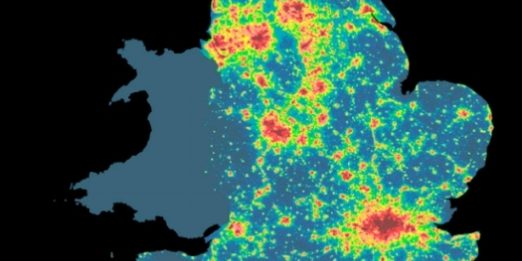Dark Skies

Last modified:
15th February 2022
The South East of England is the most densely populated and fast-growing region of the UK, so it’s not surprising that its the most light-polluted area of the whole country. 91% of Greater London is light-saturated. The few square kilometres of truly dark land are found in pockets scattered across several counties and some distance from London, including the southern coast of the Isle of Wight.
Our region has smallest proportion of its total land area within the truly dark category – just 1%. Data shows that light pollution is a major problem and one that is growing.
It’s not just that starry skies are wonderful to see. Light pollution is bad for your health! It can upset natural sleeping rhythms causing irritability and insomnia. It can increase headaches and cause anxiety. And it’s not just human beings that are affected. Many organisms need the natural rhythms of light and dark for breeding, migration and feeding – light pollution can adversely affect whole eco-systems.
And it wastes energy, and therefore precious natural resources. Turn the lights off!
Tackling light nuisance
Intrusive lighting can now be dealt with under a new criminal offence. The Clean Neighbourhoods and Environment Act classifies light pollution as a statutory offence under the Environmental Protection Act 1990.
However, the new powers are limited. It deals with light nuisance, such as a neighbour’s security light shining into your window, but not the light pollution that brightens the skies of Oxfordshire and obscures the stars. Street lights are excluded from prosecution under the Act, as are goods depots, bus and rail stations and airports. And that’s a shame.
In many of Oxfordshire’s villages, security lights from small industrial or business units, blazing all night can completely change the atmosphere of a community and not for the better!
Star Count 2022
The nationwide Star Count is an annual citizen science project from CPRE and the British Astronomical Association. The public, or citizen scientists, are asked to look heavenwards during a clear night and count how many stars within the Orion constellation they can spot.
Results from Star Count help make a map of where stargazers are enjoying dark skies and where people’s views are affected by light pollution. By showing on a map where light pollution is most serious, we can work nationally and with local councils and others to decide what to do about it
Our biggest ever Star Count, with over 7000 participants, showed that 2021 saw much lower reports of bad light pollution across the UK than in 2020. Explore the Star Count interactive map here.
Star Count 2022 – 26th February – 6th March. Read more here.
